#Flodden Field
Explore tagged Tumblr posts
Text


All that remains of the bloodiest battle on British soil is a simple cross
#Battle of Flodden#Flodden Field#Branxton#Northumberland#King James IV#King Henry VIII#Tudor era#Scottish invasion#Brainston Moor#British history#bloodiest battle#UK#1513
49 notes
·
View notes
Text

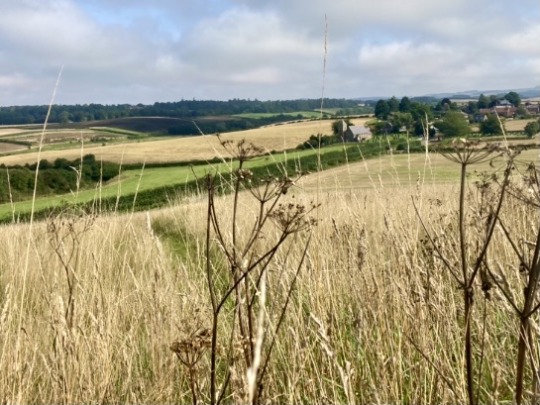
visited the site of the battle of flodden field the other day! despite studying the tudors at a level, id not appreciated the death toll of the three hour battle til now! the photo on the right shows the memorial, and the right shows the church where it’s claimed the body of king james iv of scotland was taken after his death.
#flodden field#battle#military history#tudors#memorial#history#student#study#studying#studyspo#studyblog#studyblr#uni#university#scotland#edinburgh#travel#travelblog#travelblr#travelspo#notes#exams#pens#mildliners#aesthetic#muji#deskspo#desk set up
9 notes
·
View notes
Text
David Hope, 'Flodden Field'. In 1513, there was a fight at Flodden and men of Ettrick Forest died, according to the footnote.
---
On Flodden Field the grass is green
As if no strife had ever been.
But Selkirk town a tryst must keep
To honour those so long asleep.
.
Forgotten now the ancient wrong
But cherished by all the ages long
The gallant tale of Forest men,
Who fought and came not home again.
#poetry#poem#david hope#flodden field#grass#green#strife#peace#town#tryst#honour#asleep#forgotten#ancient#ages#long#cherished#gallant#tale#forest
6 notes
·
View notes
Photo
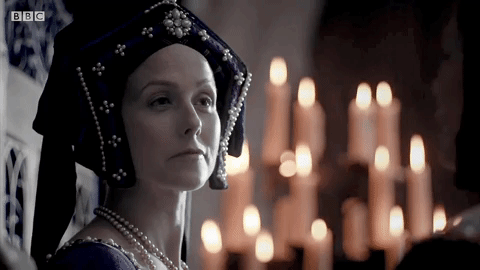

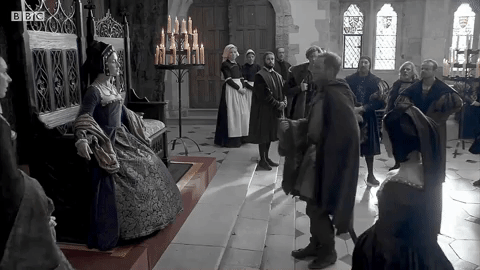
Queen Katherine set out from Greenwich, with her husband and six hundred archers dressed in long, white, wide-sleeved gabardine coats and caps, on 15 June 1513. They travelled in small stages south towards Dover. There in the castle overlooking the sea, Katherine was formally appointed Queen Governor of the Realm. She was aged about 28 and was, by then, vastly experienced in her own right as a diplomat, princess and queen. Her upbringing in Spain at the side of her mother, Queen Isabella of Castile, had coloured her childhood with high politics and war.
As soon as her husband set sail for the English port of Calais, from where he was finally to launch his campaign against the French, she was to rule in his place or, rather, in his name. She could raise armies, appoint sheriffs, approve most church appointments and spend money exactly as she wished. Henry declared that he was leaving the English people in the care of a woman whose ‘honour, excellence, prudence, forethought and faithfulness’ could not be doubted. They, in turn, were instructed to obey her every command. A small council was left behind to advise her. With power now in her hands, it was time to say goodbye. Katherine and her ladies ‘made such sorrow for the departing of their lords and husbands, that it was great dolor [pain] to behold’. Most of the army was already across the other side of the Channel.

Governing England in Henry’s absence now occupied her days. There were felons to be pardoned, prebends, canons and bailiffs to be appointed, lands and annuities to be handed out, the estates of the recently deceased countess of Somerset to be dealt with and a long-running administrative spat between the archbishop of Canterbury and the bishop of Winchester to be resolved. She also, from a distance, dealt with the affairs of Calais, in Henry’s rearguard. Letters, patents, grants and writs now carried ‘teste Katerina Anglie Regina’ (‘witnessed by Catherine, Queen of England’) rather than the ‘Teste me ipso’ (‘I have witnessed this’) of Henry. She signed them ‘Katherine [or Katherina] the Qwene’.
Katherine had pressed for war, but she was still worried that her glory-seeking husband would behave recklessly, placing himself in unnecessary danger. Shortly after he had sailed she wrote to his almoner, Thomas Wolsey, anxiously begging for weekly letters to reassure her that her hot-headed husband was safe. She also wrote to her former sister-in-law Margaret of Austria, who was now regent of the Netherlands, begging her to send a doctor to be at hand for her husband. Katherine felt safer once Margaret’s father, the Emperor Maximilian – basically serving as a paid mercenary but still a far more experienced fighter than Henry – appeared at the scene of battle. Her hope now, she told Wolsey, was that ‘with his good counsel, his grace [Henry] shall not adventure himself so much as I was afraid of before’.
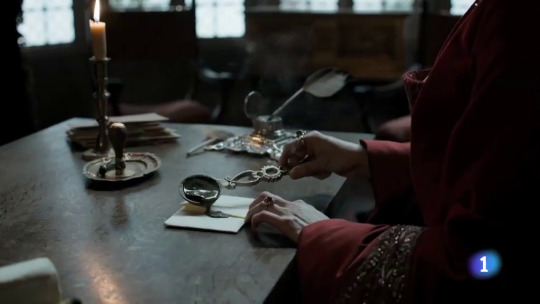
In August and September, Queen Katherine was faced with an invasion from the Scots, led by her brother-in-law James IV, who was married to Henry’s sister Margaret Tudor. James had threatened war with England if Henry went to war with France. Henry even recruited his sister to try to persuade her husband not to invade England while he was away in France. At the same time, Anne of Brittany, Queen of France was writing James, asking him to be her knight in shining armor and attack England. In the end, against the advice of his councilors, James decided to attack England. In August of 1513, James IV’s herald presented King Henry VIII with a written declaration of war. The king of Scotland was actually excommunicated by the Pope for breaking the Treaty of Perpetual Peace with England.
Katherine started preparing in July, as soon as news reached her that James IV of Scotland was mustering a large army. Early in August she demanded to know why the mayor and sheriffs of Gloucester had not responded to her letters asking how many men and horses they could supply. ‘News from the Borders show that the king of Scots means war,’ she said. There was no time for dallying. She ordered them to answer within fifteen days. In mid-August Katherine wrote light-heartedly to Wolsey asking him to tell Henry that ‘all his subjects be very glad, I thank God, to be busy with the Scots, for they take it for [a] pastime’. Katherine was not intimidated. She relished the challenge coming her way and had thrown herself fully into organising England’s defence. ‘My heart is very good to it,’ she said excitedly in a letter to Wolsey signed nine days before James led his army of up to thirty thousand men across the River Tweed. One of his first actions was to attack and take Norham Castle, belonging to the bishop of Durham. James had to be stopped before he marched farther south.
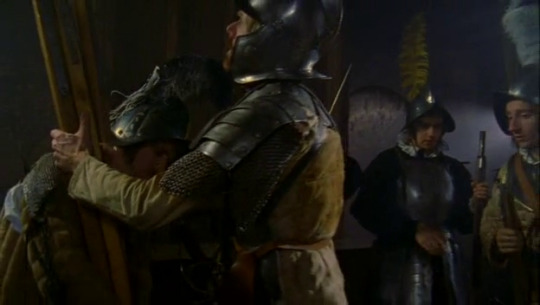
Surrey and his sons, Edmund and Thomas Howard, were in position by the beginning of September; their army gathered near Newcastle ready to march toward the enemy. Sir Thomas Lovell had another army at Nottingham; Katherine and her council had gathered a third in the south just in case the worst happened and James somehow got through the other two. The Queen was well prepared. She had been busy and not just, as she coyly told Wolsey, ‘making standards, banners and badges’. Katherine sent ten thousand pounds, a considerable sum of money, north to be guarded (and, presumably, used for war expenses) by the Abbot of St Mary, near York. She also sent artillery, gunners and a fleet of eight ships, including the Mary Rose, which carried additional troops, towards the Scottish border. Grain, pipes of beer, rope, cables and suits of light armour were also shipped north. For her first line of defence she would rely on the earl of Surrey and the troops he was raising in the northern counties, together with those that had arrived by sea. James had a large army, however, backed by some recently delivered and formidable modern French artillery.
Documents were drawn up, meanwhile, to declare Scotsmen living in England to be ‘enemies’; but that all Scotsmen that have married English women and have children may remain. All others would have their goods seized and their persons banished under penalty of their lives. All Frenchmen to have their goods forfeited and be committed to prison if they dwell near the sea coast; or else, if they dwell inland, to find sureties. Henry VIII – flush from his minor triumphs in France – decided to send Katherine one of his more illustrious captives, the duke of Longueville. Katherine was about to set off northwards towards the Scottish threat herself. The duke and six others with him would just have to stay in the Tower of London for a few weeks.
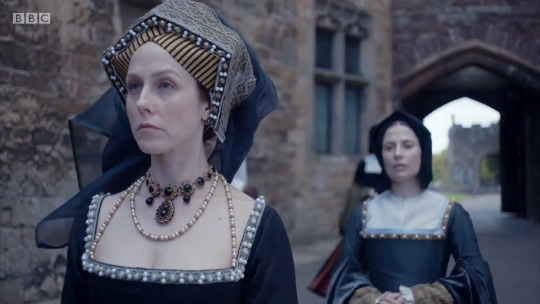
As the Scottish threat grew, in a letter dated 2 September to Thomas Wolsey in France, Katherine revealed that she was ready to head northwards. These short notes show that Katherine personally led what was left of the king’s artillery towards the North. In early September Katherine wrote to the Great Wardrobe (the central store of royal clothing and equipment behind Baynard’s Castle in London) demanding delivery of banners, standards and pennants for those who would march north with her. A herald and a pursuivant, dressed up in the coats of arms of England, were also to travel with her. It would be the herald’s job to deliver any formal battle challenges or other messages she might care to send the Scottish king. She took 1500 suits of armour, called Almain Rivets, on her journey – all part of her direct responsibility for organising England’s deep defence. Finally, so she might display a suitable amount of magnificence, six trumpeters with their trumpet banners were to accompany her.
Katherine began to move north with a body of troops variously described as ‘a great power’ or a ‘numerous force’. At this time she also ordered up a golden ‘headpiece with crown’, and had both a light sallet helmet and a rounded, broad-brimmed shapewe helmet (rather like an armoured sun hat) especially garnished – presumably with gold or jewels. There is no record of her being seen in armour. ‘Our queen also took the field against the Scots with a numerous force one hundred miles from here,’ reported a London-based Venetian. Peter Martyr, Katherine’s old professor, heard that “Queen Katherine, in imitation of her mother Isabel and imbued by the spirit of her father … made a splendid oration to the English captains, told them to be ready to defend their territory, that the Lord smiled upon those who stood in defence of their own, and they should remember English courage excelled that of all other nations”.

In the invasion crises of the previous reign, Henry VII had gathered his power at Kenilworth castle. In 1513, nearby Warwick was the destination of the queen, her guns and likely muster point for Lovell’s troops. Instead of seeking refuge in the secure Tower of London and letting her husband’s councillors take the lead, Katherine’s decisive action moved her closer to danger and confirmed her role as national commander. She would not have been involved in any battle that might have occurred had the Scots broken through on the border, but her determination to be nearby to organise the country’s stretched resources sent all the right signals to the people she temporarily ruled.
Prior to Sean Cunningham’s find, historians had only known that Katherine was in Buckingham, around 60 miles north of London, when she received word of Surrey’s victory. But the new evidence suggests that the queen intended to travel further north, if not directly into battle like Joan of Arc, then at least into the vicinity of combat. James IV’s army was routed at Flodden Field, near the Northumberland village of Branxton. The fighting, which began in the afternoon of September 9, was ferocious. Courageous men on both sides fell in bloody hand-to-hand combat, but gradually the tide turned away from the Scots to leave the English in control of the field. Many of the Scots, or so we read in English accounts, were so “vengeable and cruel in their fighting” that their opponents preferred to kill them rather than capture them alive, contemptuously leaving the corpses naked on the ground. Among the dead was the king: James struggled like a man possessed only to fall within a few feet of the great Surrey himself. The flower of the nobility died with him; so did the Archbishop of St. Andrews, two bishops, and two abbots and perhaps another eleven thousand or so of the more humble. English losses are estimated to have numbered about one thousand.
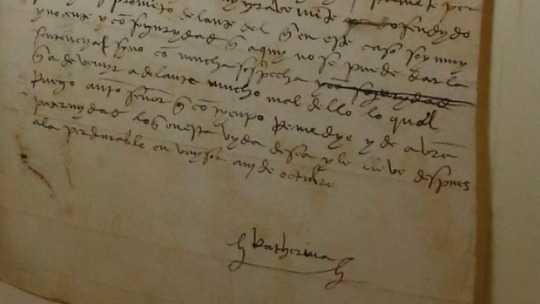
The impact of Flodden and its consequences was immediately felt in England. Surrey wrote at once to the Queen, informing her of the victory, and sent her James's banner and the bloody coat he had died in as trophies; Katherine duly sent them on to Henry by a herald. The body taken to London, which had been suitably bowelled, embalmed and cered. Then she gave devout thanks to God for Surrey's success, and returned in triumph to Richmond. On the way, she stayed the night at Woburn Abbey, and it was here that she took time to write to her husband:
Sir, My Lord Howard hath sent me a letter open to your Grace, within one of mine, by the which you shall see at length the great Victory that our Lord hath sent your subjects in your absence; and for this cause there is no need herein to trouble your Grace with long writing, but, to my thinking, this battle hath been to your Grace and all your realm the greatest honor that could be, and more than you should win all the crown of France; thanked be God of it, and I am sure your Grace forgetteth not to do this, which shall be cause to send you many more such great victories, as I trust he shall do. My husband, for hastiness, with Rougecross I could not send your Grace the piece of the King of Scots coat which John Glynn now brings. In this your Grace shall see how I keep my promise, sending you for your banners a king’s coat. I thought to send himself unto you, but our Englishmens’ hearts would not suffer it. It should have been better for him to have been in peace than have this reward. All that God sends is for the best. My Lord of Surrey, my Henry, would fain know your pleasure in the burying of the King of Scots’ body, for he has written to me so. With the next messenger your Grace’s pleasure may be herein known. And with this I make an end, praying God to send you home shortly, for without this no joy here can be accomplished; and for the same I pray, and now go to Our Lady of Walsingham that I promised so long ago to see. At Woburn the 16th of September. I send your Grace herein a bill found in a Scotsman’s purse of such things as the French King sent to the said King of Scots to make war against you, beseeching you to send Mathew hither as soon as this messenger comes to bring me tidings from your Grace. Your humble wife and true servant, Katharine.
Queen Katherine tactfully credits the victory against the Scots to Henry himself. She understood Henry and his desire for glory. Even while engaged in the Scottish campaign, she never forgot to congratulate him fulsomely on all that he did. According to many historians, Katherine had the intention of sending James's body (some even say "head") as a trophy to her husband, but the Englishmen thought it was too crude so she settled his bloodstained coat instead. I think Katherine’s letter is misinterpreted. In my opinion Katherine wanted to send James as a prisoner to France, in exchange for Henry sending her the Duke of Longueville – that’s what she meant by saying she intended to send the king’s person, but the stout ‘English hearts’ would not stand for it (and killed James) so she sent his bloodied coat instead. Katherine did not even dare to order the burial of James’s corpse without Henry’s agreement. She sent a message to Queen Margaret, offering her consolation for a husband killed by her own soldiers. ‘The queen of England, for the love she bears the queen of Scots, would gladly send a servant to comfort her,’ it said. Soon Friar Langley was on his way.
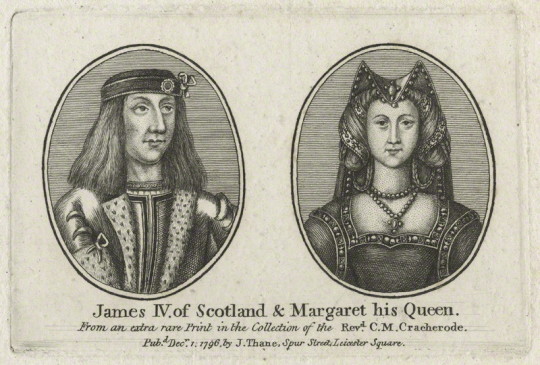
The island of Britain was, temporarily and for the first time, in the hands of two women. Katherine governed England as regent for her husband. It was her task to administer the victory. The newly widowed Margaret ruled in Scotland as protector for her one-year-old son, James V. The infant king had been crowned shortly after his father’s death at what, because of the tears shed for the dead left behind at Flodden, became known as the ‘Mourning Coronation’. Within a fortnight of Flodden, the talk was already of a truce. Katherine’s commanders in the north wrote recommending an end to the war. Many of the remaining Scottish nobles, however, were hankering for revenge and Katherine was asked to decide whether troops should be permanently billeted at certain points near the border. The situation was by no means stable and war could have flared again at any time.
Katherine continued to oversee negotiations for a truce with the Scots, and showed great skill in her diplomatic messages to her man on the spot, the bishop of Durham. Langley acted as an intermediary in the negotiations for a truce that was not finally signed until the following February. At the same time, Katherine instructed Lord Dacre to assert King Henry’s right to become guardian of his nephew, the young James V of Scotland – potentially re-opening the troubled English claim to overlordship of Scotland. Henry VIII also did his bit to improve relations by begging the pope for permission to bury James IV at St Paul’s, even though the latter had been excommunicated for breaking a papally sanctioned treaty of nonaggression with England.
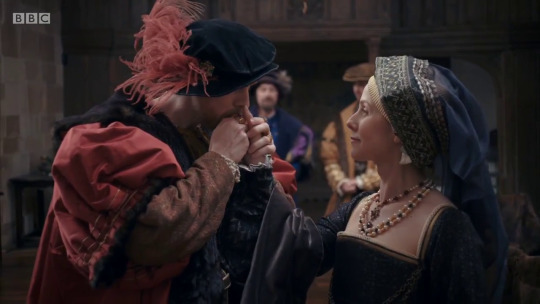
Katherine oversaw the unwinding of the war machine, paying soldiers’ and sailors’ wages and signing off on the costs of artillery, shipping and transport. Even while at Walsingham, where she would have walked the last mile to the Virgin Mary’s shrine barefoot, she still had to oversee the day-to-day running of a country where domestic worries began to take precedence. The plague, for example, was killing three or four hundred Londoners a day. Although proud of the Scottish defeat and her own performance as regent, Katherine wanted Henry home. There would be “noo joye” here without him, she confided. On 21 October Henry sailed from Calais to Dover. He rushed eagerly home to Katherine, riding ‘in post’ to Richmond ‘where was such a loving meeting that every creature rejoiced’. They were back together again, this time as a pair of young conquerors.
There had been rumours that she was pregnant and had lost a child while Henry was away. Now was a good time to start again. According to Julia Fox we cannot know whether those ambassadors who stated that she gave birth in the autumn of 1513 were right, but it is doubtful. Certainly no baby or miscarriage is mentioned in her correspondence, and it seems unlikely that she would have risked a much-wanted child by accompanying the army from London. But her mother, Isabella I of Castile, despite being pregnant rode with the troops.
At that stage of her life, as Henry’s regime sent thousands of English soldiers to fight on the Scottish border, in France and at sea, Katherine was an ideal partner for her dynamic and aggressive husband. The chamber books and related papers can still offer much to deepen our understanding of how Henry and Katherine’s marriage developed, changed and soured over the following 25 years – a relationship that came to have a powerful influence on the course of the nation’s history.
Sources:
Catherine of Aragon, Henry’s Spanish Queen by Giles Tremlett
Sister Queens: The Noble, Tragic Lives of Katherine of Aragon and Juana, Queen of Castile by Julia Fox
Letters and Papers, Foreign and Domestic, of the Reign of Henry VIII, Volumen 1 by J. S. Brewer
https://tudorsandotherhistories.wordpress.com/2015/09/09/a-field-of-blood-and-glory-flodden-field/
https://thefreelancehistorywriter.com/2012/10/27/the-battle-of-flodden/
https://blog.nationalarchives.gov.uk/katherine-of-aragon-and-an-army-for-the-north-in-1513/
https://www.smithsonianmag.com/history/when-catherine-aragon-led-englands-armies-victory-over-scotland-180975982/#.X4wBqV0fcr4.twitter
#Katherine of Aragon#Catherine of Aragon#Flodden Field#Katherine's regency#British history#Catalina de Aragon#Women in history
122 notes
·
View notes
Photo





Flodden Field, England
0 notes
Photo



Battle of Flodden field, 1513, from the book "The Border reivers", plate by Angus McBride
34 notes
·
View notes
Photo


"There is another story about Katherine, a different story. Henry went to France to have little war; he left Katherine as regent. Down came the Scots; they were well beaten, and at Flodden the head of their king cut off. It was Katherine, that pink-and-white angel, who proposed to send the head in a bag by the first crossing, to cheer up her husband in his camp. They dissuaded her; told her it was, as a gesture, un-English. She sent, instead, a letter. And with it, the surcoat in which the Scottish king had died, which was stiffened, black and crackling with his pumped out blood." ~Wolf Hall, p.37.
20 notes
·
View notes
Photo

Flodden Field, deathplace of James IV
The Battle of Flodden was a conflict between the Kingdom of England and the Kingdom of Scotland. The battle was fought in the county of Northumberland in northern England on 9 September 1513, between an invading Scots army under King James IV and an English army commanded by the Earl of Surrey. It was an English victory. In terms of troop numbers, it was the largest battle fought between the two Kingdoms. James IV was killed in the battle, becoming the last monarch from the British Isles to suffer such a death to date.
#flodden field#battle of flodden#james iv#northumberland#england#uk#scenery#flowers#landscapes#yellow#history
38 notes
·
View notes
Video
youtube
The Floo'ers O' The Forest
A lament for the army of James IV, the flower of Scottish manhood, slain with their king on the field of Flodden, September 1513.
5 notes
·
View notes